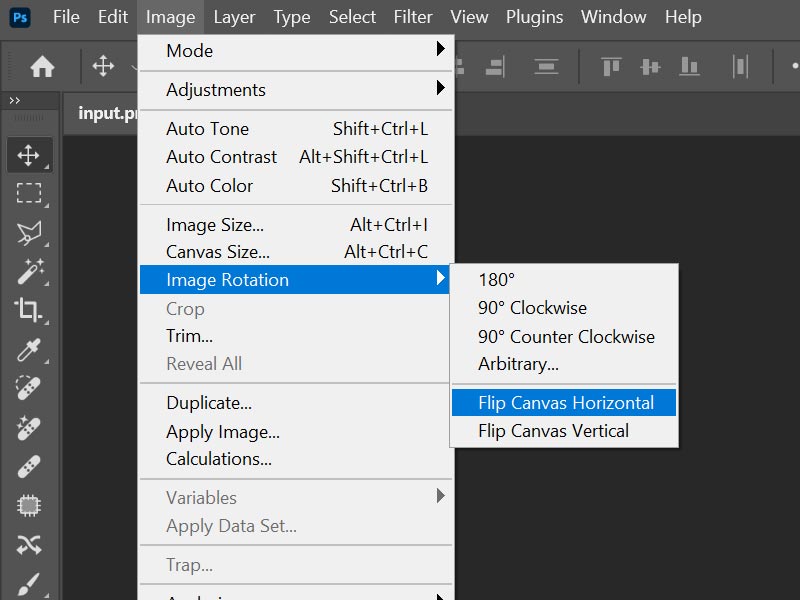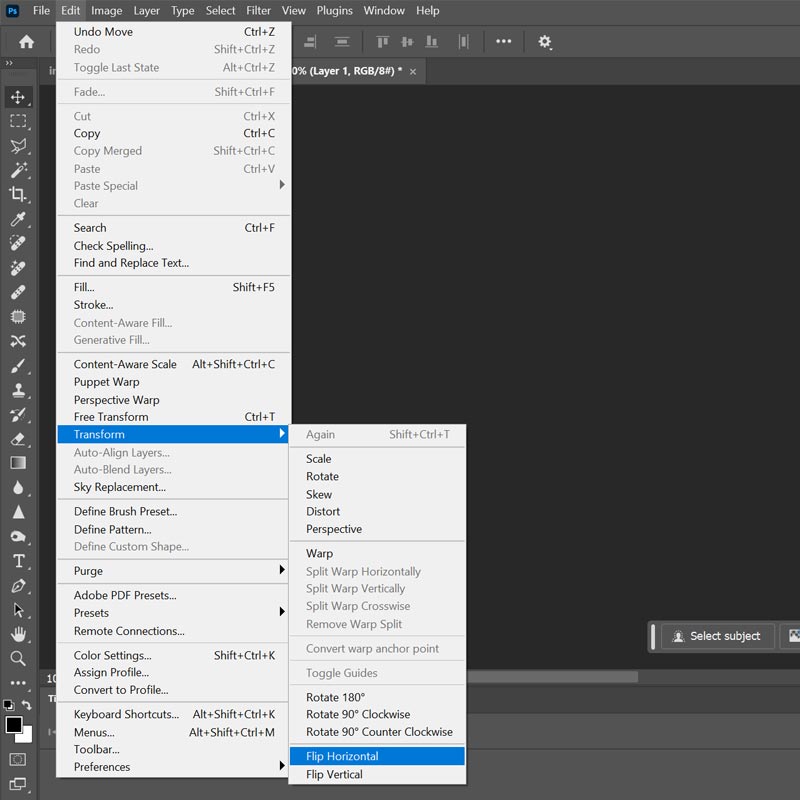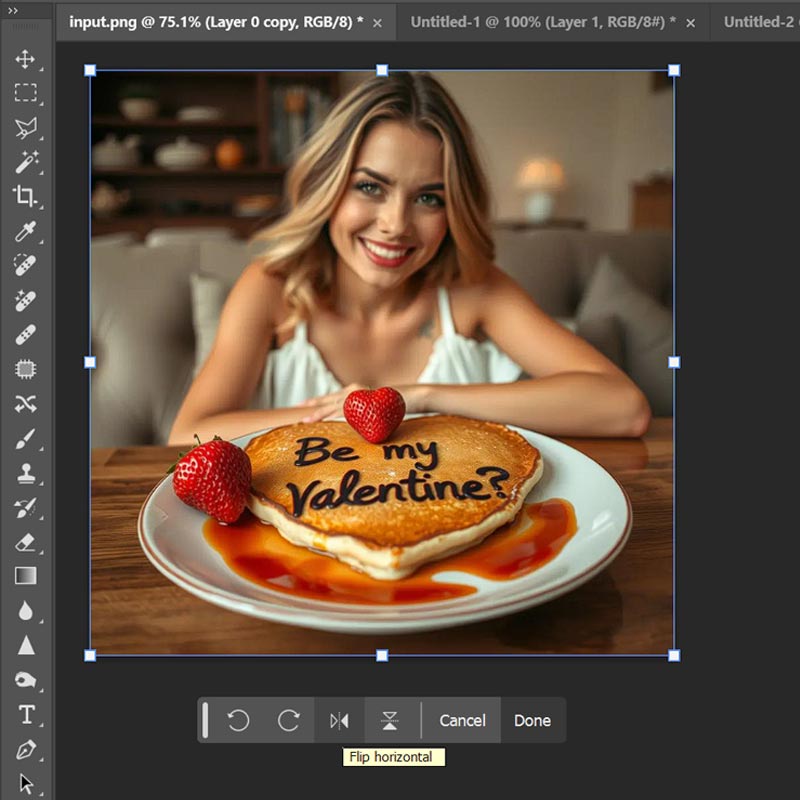Introduction to Flipping Images
Flipping an image in Photoshop is a simple yet powerful technique that can enhance your photo editing skills. Whether you need to correct an image's orientation or create a image flipper mirror effect, Photoshop offers easy methods for beginners to achieve these results. This guide will walk you through the process, ensuring you can flip images confidently.
How Do You Flip an Image in Photoshop
Let’s go over the different methods. People who are searhing for flipping in Photoshop, they are usually interested in one of these methods:
- Flipp Canvas in Photoshop: This affects all layers and is ideal for whole-image adjustments.
- Flip Layer in Photoshop: This allows you to modify just one layer, offering more control. This is what people are actually looking for when they need to flip an image in Photoshop.
Both methods are straightforward, and we'll cover step-by-step instructions for each.
Step-by-Step Guides
❶ How to Flip Canvas in Photoshop
- Open your image in Photoshop.
- Go to the Image menu, hover over Image Rotation, and select Flip Canvas Horizontal for a left-to-right flip or Flip Canvas Vertical for a top-to-bottom flip.
- There is NO flip canvas Photoshop shortcut, but you can set custom ones via Edit > Keyboard Shortcuts.

❷ How to Flip Layer in Photoshop
- Select the layer you want to flip from the Layers panel.
- Use the menu by going to Edit > Transform, then choose Flip Horizontal or Flip Vertical.
- Alternatively, press Ctrl + T (Windows) or Command + T (Mac) to enter Free Transform mode, right-click, and select Flip Horizontal or Flip Vertical.
- There is NO how to flip image in Photoshop shortcut; use the right-click menu instead or set custom ones via Edit > Keyboard Shortcuts.

Survey Note: Detailed Analysis of Flipping Images in Photoshop
This section provides a comprehensive exploration of flipping images in Adobe Photoshop, tailored for beginner-level users and intended for publication on psd-dude.com. It includes all details from the initial analysis, ensuring a thorough understanding of the process, methods, and practical applications.
Introduction and Background
Flipping an image in Photoshop refers to creating a mirror-like reversal, either horizontally (left to right) or vertically (top to bottom). This technique is essential for various purposes, such as:
- Correcting image orientation,
- Creating symmetrical designs, or
- Adding creative effects like reflections.
With over 20 years of experience using Photoshop, I have created commercial Photoshop add-ons, authored in-depth tutorials, and produced Photoshop video content. As the creator of psd-dude.com, a leading resource for Photoshop enthusiasts, I have published hundreds of tutorial guides, sharing expert insights on photo editing, graphic design, and creative effects. My extensive hands-on experience ensures that the methods and tips in this guide are accurate, practical, and aligned with industry best practices.
Methods to Flip an Image in Photoshop
There are two primary methods for flipping images, each serving different needs:
- Flip Canvas in Photoshop: Flipping the entire canvas method affects the whole image, including all layers, and is suitable for global adjustments. I found in Adobe's official guide that this is done via the Image > Image Rotation > Flip Canvas Horizontal/Vertical menu options.
- Flip Layer in Photoshop: Flipping a specific layer method allows for more granular control, affecting only the selected layer. Sources like Skylum's blog and Adobe's layer flipping guide confirmed that this can be achieved through Edit > Transform > Flip Horizontal/Flip Vertical or using the Transform tool with Ctrl + T (Windows) or Command + T (Mac), followed by a right-click to select the flip option. If you want to flip text in Photoshop,use also the Ctrl + T method.
The distinction between canvas and layer flipping is critical for beginners, as confusing these can lead to unintended changes.
Step-by-Step Guides with Visual Aids
To ensure clarity here's how the Photoshop menus for flipping imageslook like. I've made a few screenshots to illustrate the process.
| Photoshop Flip Image Alternatives | Screenshot |
|---|---|
| Open image and navigate to Image menu for canvas flip |

|
| Select Edit menu for layer flip using Transform |

|
| Use Transform tool in Free Transform mode |

|
These visual aids are useful for Photoshop beginners, as they provide a visual reference to complement the textual instructions.
Unexpected Detail: Custom Shortcuts
An interesting aspect is that while Photoshop doesn't offer default shortcuts for flipping, you can customize them, which can save time for frequent users. This flexibility is particularly useful for beginners looking to streamline their workflow. I put Ctrl + , for flip image vertically and Ctrl + . for flip image horizontally.
Keyboard Shortcuts and Customization
There are no default keyboard shortcuts for directly flipping images in Photoshop. However, users can enter Free Transform mode using Ctrl + T (Windows) or Command + T (Mac), and then right-click to select flip options. For canvas flipping, custom shortcuts can be set via Edit > Keyboard Shortcuts, navigating to the Image Rotation menu. I highlighted this customization as a way to enhance efficiency, particularly for frequent users, and noted it as an unexpected detail for beginners who might assume all functions have default shortcuts.
Tips and Tricks for Practical Application
Practical applications of flipping were explored to provide value beyond the basic steps. These include:
- Creating Symmetrical Designs: Duplicate a layer, flip it horizontally or vertically, and position it next to the original for mirror effects. This can be enhanced by merging layers and adjusting, as suggested in my tutorial on mirror reflection effects (Mirror Reflection Image Effect in Photoshop).
- Correcting Image Orientation: Useful for portraits or photos where the subject faces the wrong direction, improving composition.
- Working with Text: Ensure text readability after flipping, especially for left-to-right languages, by adjusting via the Character panel if needed.
- Flipping Selections: Make a selection, go to Select > Transform Selection, and flip, which is ideal for partial image adjustments.
- Using Layer Masks: After flipping, apply layer masks for blending, such as creating reflections with gradient masks, enhancing creative outputs.
I gathered these tips from various sources to create a comprehensive guide that helps beginners apply flipping in real-world scenarios.
Common Mistakes and How to Avoid Them
I identified several potential pitfalls that are particularly relevant for beginners:
- Confusing Canvas and Layer Flipping: Ensure you select the correct method based on whether you want to affect the whole image or just a layer.
- Forgetting to Select the Correct Layer: Always check the active layer in the Layers panel to avoid unintended flips.
- Not Saving Work: Save incrementally to prevent losing changes, especially during experimentation.
- Overlooking Aspect Ratio: Be aware that flipping maintains the aspect ratio, but additional cropping or resizing might be needed.
- Ignoring the Background: Consider how flipping affects transparent backgrounds or design elements, ensuring consistency.
These mistakes were highlighted to help users avoid frustration and maintain project integrity.
Flip Image Online
Flipping an image online is quick and easy with various free tools available. Whether you need to flip horizontally for a mirror effect or flip vertically to rotate upside down or to make a reflection effect, online editors let you do it in just a few clicks.
Try the Image Flipper from MockoFun for really quick results.

Websites like MockoFun, Canva, Fotor, and Adobe Express offer simple features like flip picture online, making it perfect for both casual users and professionals. No software download is needed—just upload your image, flip it, and download the final version instantly. Ideal for social media, design projects, or quick adjustments on the go.
In Conclusion
The conclusion reinforces that flipping images in Photoshop is accessible and versatile, suitable for correcting orientation, creating designs, and adding effects. The guide, with its step-by-step instructions and practical tips, ensures beginners can master this skill, aligning with the audience's needs on psd-dude.com. The inclusion of custom shortcut options and detailed visual aids adds depth, making this a comprehensive resource for learning.
So, now you know all there is to know about how to flip an image on Photoshop, how to flip a layer in Photoshop and how to flip image online!







No comment(s) for "How to Flip an Image in Photoshop"